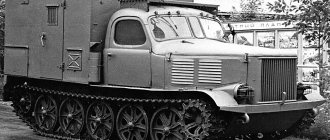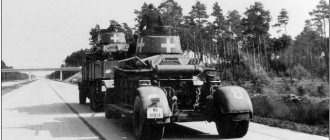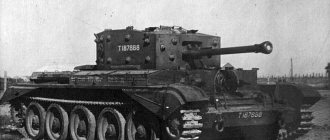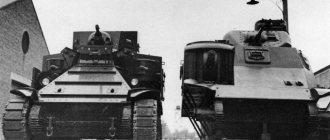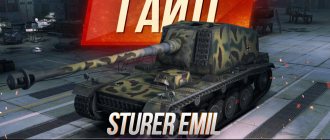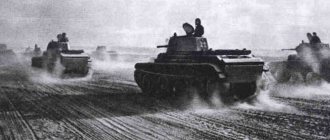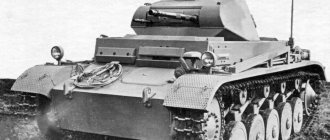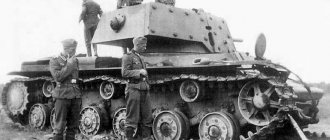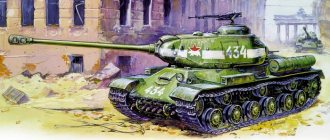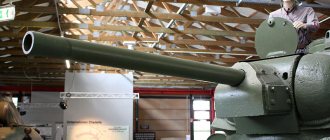Home » Books on the history of tanks » Yuri Pasholok. Light tank 7TP - modernization of a 6-ton tank in Polish
Books on tank history
boroda 03/15/2019 1607
10
in Favoritesin Favoritesfrom Favorites 7
The pride of Polish tank builders during the interwar period was the 7TP light tank. This vehicle, an upgraded version of the Vickers Mk.E , formed the backbone of the Polish tank force at the start of World War II. Skillfully using the developments of the Swiss company Saurer (engine) and the Swedish company Bofors (weapons and turret), Polish designers were able to significantly improve the characteristics of the original tank. The 7TP design also used a number of Polish designs, including the very successful Mk.IV periscope device. In the 1939 campaign, Polish tanks fought on equal terms with German ones, and later some of them ended up in German service. Several tanks ended up in the USSR, where they became the object of study.
Swift Raid Trophies
For the Soviet military, the development of the Polish version of the Vickers Mk.E was not news. For a long time, the Polish Army was considered one of the most likely opponents of the Red Army, so the interest of the Soviet military in Polish armored vehicles was understandable. The existence of the 7TP became known back in 1935, when the first vehicles of this type were shown at a parade. True, information about the Polish tank in the USSR was not entirely reliable; for example, there was some misconception about the power plant. In addition, the Vickers Mk.E with massive air intakes, which were introduced into the design due to engine overheating, was adopted as the second version of the 7TP. The USSR also knew about the C7P tractor, which was developed on the basis of the 7TP.
By the beginning of World War II, Polish armored vehicles were generally one of the most studied by the Soviet military. A larger amount of information was available only on the armored vehicles of Czechoslovakia, since the USSR had developed close military-technical cooperation with this country since 1937.
Polish light tank 7TP after restoration. NIBT Test Site, 1940
Despite the fact that Poland was considered for a long time in the USSR as the main potential enemy, truly large-scale hostilities between the states never occurred. By September 17, 1939, when the “liberation campaign” began, Poland had already de facto lost the war. By the time the Red Army went on the offensive, the main part of the Polish army was still fighting defensive battles with the Germans in the west, but the evacuation of government institutions and the withdrawal of army units was already in full swing, mainly through Romania and Hungary. These facts explain the small losses of the Red Army and the not very intense resistance of the Polish troops in the east.
Of course, there were serious battles, but the appearance of Soviet tanks in Lviv at 2 a.m. on September 19 speaks volumes. These vehicles were part of the 24th Light Tank Brigade under the command of Colonel P.S. Fotchenkova. In Lvov they had to fight not with the Poles, but with the Germans, who were also entering the city. Both sides suffered minor losses. As for Polish tanks, they never had the chance to come face to face with Soviet combat vehicles.
Around the same time that Soviet tanks were approaching Lwów, the 10th Motorized Cavalry Brigade, under the command of Stanisław Maciek, was fighting the Germans near Tomaszów Lubelski. Part of the brigade was able to break through towards the border with Hungary. The Hungarians received Polish equipment, including TK-S wedges, and interned Polish soldiers were later able to move to France and continued to fight the Nazis. The main part of the brigade's tanks ended up in the hands of the Germans. Among the armored vehicles captured by the Wehrmacht were Renault R 35, which did not really fight, Vickers Mk.E, 7TP, C7P and TK-S. They ended up at a collection point for emergency vehicles (SPAM), organized in the Tomaszów Lubelski area.
The car still has its original Polish camouflage
By October 5, negotiations on the division of Polish territory were completed between the USSR and Germany. The Red Army began to retreat to the positions specified in the agreement. At the same time, the execution of the order to evacuate captured property began. During its course, an extremely extraordinary raid took place, carried out in early October 1939. Apparently, the command of the 24th Light Tank Brigade somehow found out about SPAM near Tomaszow Lubelski. On October 6, a flying detachment of 152 people was formed from the brigade, whose task was to collect trophies. After the raid carried out by this unit, the Germans were missing 10 Polish tankettes, 9 Polish and 2 German tanks (Pz.Kpfw.II Ausf.C), as well as 3 dozen guns. Among the Polish tanks were several 7TP and Vickers Mk.E.
The brigade's trophies became the richest "catch" of the Red Army until the beginning of the Great Patriotic War. Before this raid, trophies were limited to single specimens. Since the equipment was taken from the collection point for emergency vehicles, all tanks and tractors required repairs. This is also why the flying squad took several copies of the same type of vehicles at once.
Gallery[edit]
- Field tests of 7TR, the tank overcomes an embankment.
- Tank company at 7TR.
- Column of tanks 7TP, 1938
- Polish 7TR tanks enter the Czech city of Cieszyn (Cieszyn). October 1938
- The first prototype of a tank with a new turret and 37 mm gun, 1936.
- Assembly shop with finished 7TP jw, presumably 1927
- 7TP jw overcomes concrete obstacles at the training ground, 1938.
- 7TR jw during Polish Army exercises, 1938
- 7TR jw during Polish Army exercises, 1938
- 7TP jw Wehrmacht security unit, presumably 1940
- 7TP jw captured by German troops in Poland and put on display in Lepzig, March 5, 1940.
- 7TP jw at a collection point for captured equipment, 1939
- 7TP jw at a collection point for captured equipment, 1939
- 7TR jw of one of the Wehrmacht training units, presumably 1940.
- 7TR jw of one of the Wehrmacht security units on the Eastern Front, presumably 1941.
- Captured 7TP jw at the front, presumably 1940.
High quality tank
The captured Polish tanks ended up at repair base No. 7 (Darnitsa, Kyiv). From there, part of 7TP and C7P was sent for study. 7TP with numbers 5057, 5091 and 5097, as well as C7P with number 1153, arrived at the NIBT Test Site in Kubinka near Moscow. All vehicles that arrived at the test site were not in driving condition. For this reason, it was decided to use two tanks as spare parts donors.
The vehicle's serial number 5091 was marked on the rear of the vehicle.
It was decided to restore the car number 5091, built in 1938. Landfill workers completely dismantled the car. The main donor of spare parts was tank number 5097, which had more damage. Parts of this tank were also used to restore the C7P tractor.
Unlike the Pz.Kpfw.II Ausf.C, which was only partially restored, the Polish tank was restored to fully operational condition. This made it possible not only to study the car, but also to conduct full sea trials later. Individual components and assemblies of the tank were described in detail, and their diagrams were drawn up. The fact that the tanks did not fall into the hands of Soviet specialists in a single copy made it possible to use individual elements of their design as visual aids.
Diagram of the 7TP engine-transmission group. In Soviet correspondence the tank was called "Vickers Polish"
Soviet experts did not expect any special revelations from the 7TP tests. By the summer of 1940, when the restoration of the tank was completed, the study of the captured Vickers Mk.E tank from the Finnish army was in full swing at the NIBT Test Site. The Polish and Finnish vehicles were related by the turret and armament manufactured by Bofors. In addition, we should not forget that the USSR produced the T-26, which was a Soviet copy of the Vickers Mk.E, since 1931. Back in the mid-30s, they tried to replace the T-26, but the T-46 turned out to be too complex and expensive. At the end of the 30s, the T-26 was modernized, and in the winter of 1940, taking into account the war with Finland, a program to create a new tank (SP) was launched. It is clear that Soviet specialists could only be interested in certain elements of the Polish machine.
The Saurer diesel engine has become the most interesting element of the engine-transmission group
The most interesting element of the tank was the engine. People in the USSR were familiar with the Saurer diesel engine. Experts accurately determined the origin of the engine: the same Swiss engines were installed on Saurer Dauntless trucks. It is because of this motor that the engine compartment of the 7TP has increased in volume. However, the test site specialists were interested in the motor, since Soviet light tanks were also planned to be equipped with diesel power plants. The Swiss motor turned out to be low-power and too large for these purposes, but its design itself was interesting. 7TP was one of the first production tanks with a diesel engine. In the USSR, work on a diesel engine had been going on since the early 30s, but mass production of tank diesel engines began only in 1939. Another feature of the Polish tank was the design of the main clutch with a multi-plate dry clutch. The gearbox as a whole was similar to the one on the T-26, but it had a number of differences. For example, different gear ratios, which was, in turn, associated with the installation of a new engine.
Design of the main clutch installed on a Polish tank
The tracks were redesigned and received new pins. They became slightly lighter than the Vickers Mk.E and T-26 tracks, while the width increased from 260 to 268 mm. Thus, it was possible to reduce the specific pressure on the ground and compensate for the increase in mass. The 7TP suspension was similar to that used on the Vickers Mk.E and T-26, but had some differences - the number of springs was reduced, a rigid lever appeared, which reduced the load on the springs. In addition, the design of the sloth was strengthened, and the T-26 sloth was similarly strengthened.
7TP chassis diagram
The turret of the Polish tank, as mentioned above, was similar to the turret of the Finnish Vickers Mk.E. Both towers were descended from Bofors designs. But Polish engineers added a number of changes to the turret design during the production of the 7TP. As a result, the Polish tower became better than the “original”. For example, a ventilation system appeared here, which in combat conditions was an absolute plus.
Diagram of a Polish tank turret
There were significant differences in the installation of weapons. The general concept of the gun mount, which was developed by Bofors for the Strv m/31, has remained unchanged. But 7TP had a turret that was different from the Swedish design from the very beginning. The top sheet turned out to be simpler, which at the same time made its production less difficult and improved bullet resistance. The gun's armor was also simplified, while its durability also improved. Even more significant was the difference between the 7TP gun mount and the one found on the Finnish Vickers Mk.E.
The 7TP gun mount turned out to be more successful than the original Swedish design
Some changes turned out to be due to the fact that the 7TP had different auxiliary weapons. Instead of the Swedish version of the Schwarzlose M.07/12, the Ckm wz.30 machine gun, the Polish version of the Browning M1917, was paired with the cannon. This machine gun was slightly larger, so its installation, including the armor, had to be redone. Otherwise, the twin machine gun and cannon setup was very similar to the one Bofors developed for the Strv m/31.
Gun mount, rear view
While the Finnish vehicle had a large hatch in the center of the turret roof, the Polish vehicle had it moved to the right. The design of this hatch was somewhat reminiscent of the one installed on the Strv m/31. By the way, it did not appear right away: at first, the turret crew entered the fighting compartment through a double-leaf hatch in the stern. The new hatch appeared simultaneously with the appearance of the aft niche in which the radio station was installed.
Roof of the 7TP tower. Number 1 indicates the commander's periscope, and number 3 indicates the gunner's periscope sight in armor.
Where the Polish tank was significantly superior to the Swedish vehicle was in visibility. The turret of the Swedish tank contained fairly simple side viewing devices, plus two periscope devices in the roof of the turret. He inherited all this from the German Leichttraktor, whose turret was taken as a basis by Bofors designers. As for the Polish car, it received much more advanced viewing devices. Instead of simple glass blocks, prismatic viewing devices were installed in the sides of the turret, preventing bullets from directly hitting the tanker using them. By the way, the Finnish tank also had side viewing devices with prisms, but of a slightly different design.
The periscopic viewing device used by the gunner of the Polish tank turned out to be much more advanced. At the same time, it was also a periscope sight, connected by a rod to the gun mount. The sight has not been completely preserved, but its design aroused great interest among Soviet specialists. The tank being tested did not have a telescopic sight; Soviet specialists considered it auxiliary.
Gunner's periscope sight
The greatest interest was generated by the periscope device, better known as MK-IV. It was developed by Rudolf Gundlach, and the British company Vickers began producing this device under license. Periscope devices existed before this, but Gundlyakh’s brainchild turned out to be truly revolutionary. Firstly, the device turned out to be simple and compact, while providing all-round visibility. Secondly, its prism consisted of two parts (plus an additional prism for observation in the rear hemisphere). If the upper half was damaged, it could be quickly replaced without leaving the tank.
The technologically advanced and very convenient viewing device quickly spread throughout the world. True, Gundlyakh’s brainchild was not immediately accepted in the USSR. A similar device appeared on Soviet vehicles only in 1943, and it was copied from the device installed on the English Churchill MK-IV tank. Hence the Soviet name for the periscope - Mk-IV.
Longitudinal section 7TP
As on the Finnish Vickers Mk.E, on the 7TP the cartridges for the gun were stowed on the side. Polish designers arranged it more rationally, thanks to which the ammunition load increased from 50 to 70 rounds of 37 mm caliber. This, however, was much less than on the T-26, even in the radio version. Another thing is that the main part of the T-26 ammunition was in suitcases on the floor of the fighting compartment, and it was not very convenient to use it.
Track reset during testing. The T-26 also suffered from similar problems.
After the tank was restored and a technical description was drawn up, sea trials began. They were held from October 7 to October 11, 1940. The car covered 312 kilometers, of which 135 were on the highway, 118 on country roads, the rest of the mileage was covered during special tests. The maximum speed of the car reached 34.7 km/h. This turned out to be slightly less than the T-26, which developed 38 km/h in the same conditions. But the average speed turned out to be higher - 25 km/h versus 23.8 km/h for the T-26. The power reserve was 195 kilometers. This turned out to be more than the Vickers Mk.E, but less than the T-26 (269 kilometers), which had larger fuel tanks. At the same time, in terms of fuel consumption, the diesel engine of the Polish tank was more economical.
Overcoming the climb
The advantage of the diesel engine was especially evident when driving on a country road. The average speed of the 7TP on the country road was 17.2 km/h, and the T-26 was 15.5 km/h. The cruising range of the tanks along the countryside was 130 kilometers for the 7TP and 159 kilometers for the T-26. At the same time, the 7TP had a total tank volume of 110 liters, the Vickers Mk.E had 180 liters, and the T-26 had 290 liters! It is not surprising that the Soviet military also wanted diesel engines for their tanks. The difference in weight between Polish and Soviet tanks turned out to be very small (9.9 and 10.5 tons, respectively).
The maximum roll level was 20 degrees
The maximum angle of climb was 32 degrees, then the tracks of the Polish tank began to slip. Track traction also proved to be a limiting factor when driving on slopes. The maximum roll level was 20 degrees. Due to problems with adhesion to the surface, the tank was unable to overcome the 1.6-meter-long ditch. It is worth noting that similar characteristics of the T-26 were no better. The Vickers Mk.E suspension had not only advantages, but also disadvantages. That is why the Americans abandoned it on the Light Tank T2, making a new suspension with an increased diameter of the road wheels.
The Polish tank could not overcome a ditch 1.6 meters wide and 0.5 meters deep
Unlike the Japanese Ha-Go light tank, which Soviet experts gave a negative assessment, the 7TP received neutral reviews. Yes, for Soviet tank building its design was yesterday, but the Polish car was not called bad either. The viewing devices were praised, and the suspension was noted to improve. The high quality of the tank's workmanship was also noted. The design of the main clutch was also considered interesting for the tank industry.

